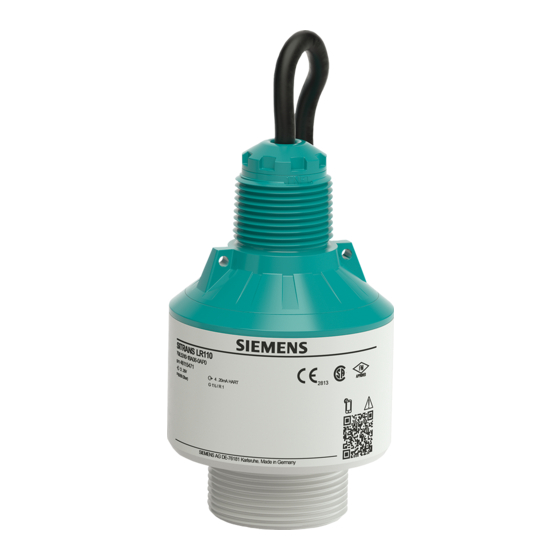
Siemens SITRANS L Application Examples
Using sitrans lr in a stilling well
Hide thumbs
Also See for SITRANS L:
- Operating instructions manual (269 pages) ,
- Compact operating instructions (114 pages) ,
- Operating instructions manual (60 pages)
Table of Contents
Advertisement
Quick Links
Advertisement
Table of Contents

Summary of Contents for Siemens SITRANS L
- Page 1 Introduction Applications SITRANS L Advantages Guidelines Using SITRANS LR in a Radar installation and Stilling Well commissioning requirements Application examples Propagation factor Using the CLEF position detect parameter for optimum accuracy 04/2020 AG070814...
- Page 2 Note the following: WARNING Siemens products may only be used for the applications described in the catalog and in the relevant technical documentation. If products and components from other manufacturers are used, these must be recommended or approved by Siemens. Proper transport, storage, installation, assembly, commissioning, operation and maintenance are required to ensure that the products operate safely and without any problems.
-
Page 3: Table Of Contents
Table of contents Introduction ..............................4 Objective .............................. 4 Disclaimer ............................4 Applications ..............................5 Advantages ..............................6 Guidelines ..............................7 Radar installation and commissioning requirements ................9 Propagation factor ........................... 10 Using the CLEF position detect parameter for optimum accuracy ..........11 Using SITRANS LR in a Stilling Well Application examples, 04/2020, AG070814... -
Page 4: Introduction
Introduction Objective A stilling well, or by-pass pipe, is a conductive pipe used to create a quiet, stable environment for a radar transmitter. These important guidelines will help you achieve successful results when considering this type of application. Disclaimer Note While every effort is made to verify the following information, no warranty of accuracy or usability is expressed or implied. -
Page 5: Applications
Applications Applications that may benefit from a stilling well or by-pass pipe: • Foaming and/or turbulent surfaces, such as a wet-well or an evaporator process. • Very low dielectric liquids such as LPG, LNG, liquid nitrogen, or liquid oxygen. • Applications where there are obstructions that are within the beam path of the radar transmitter. -
Page 6: Advantages
Advantages Signal to noise is improved in a stilling well. • Signal strength is extremely high over the entire measurement range since no beam spreading losses can occur in the stilling well. • Material surfaces that would reflect poorly without the stilling well can be measured reliably within the stilling well. -
Page 7: Guidelines
Guidelines Stilling well design guidelines Please consider the following when setting up a still well: • Pipe must be conductive. Plastic pipes are not suitable. • Smaller diameter pipes will yield better accuracy than larger diameter pipes. Fewer propagation modes will exist, leading to more consistent echo shapes over the measurement range. - Page 8 Guidelines • A vent hole must be provided near the top to prevent an air lock. • Slots or holes in the pipe should be at least smaller than 1/10 of the diameter of the pipe. Slots or holes are common in pipes in the hydrocarbon industry to accommodate either for the fact that the material in the tank isn’t homogeneous, or water could be present at the bottom of the tank.
-
Page 9: Radar Installation And Commissioning Requirements
Radar installation and commissioning requirements • A horn antenna will match better than a rod antenna for 6 GHz radar transmitters. This will result in lower noise levels on the signal as well as improved accuracy. • Horn diameter must match the pipe diameter. A horn diameter that is smaller than the pipe diameter could result in significant measurement errors due to alternate mode interference. -
Page 10: Propagation Factor
Propagation factor The path of the signal in a pipe is not direct because it interacts with the internal pipe walls resulting in a longer path for the radar signal. To compensate, the distance calculation must use a speed factor that is slower than the speed of light. This propagation speed factor is dependent upon the pipe diameter and the frequency used. -
Page 11: Using The Clef Position Detect Parameter For Optimum Accuracy
Using the CLEF position detect parameter for optimum accuracy When using a stilling well, the peak of the return echo inside the pipe could become slightly wider than it would in free space, leading to inaccuracy. Optimum accuracy can be achieved by using the CLEF position detect parameter setting over the entire range. The position detect parameter should be set to CLEF, and the CLEF range parameter should be set the same as the Lo Calibration point value.







